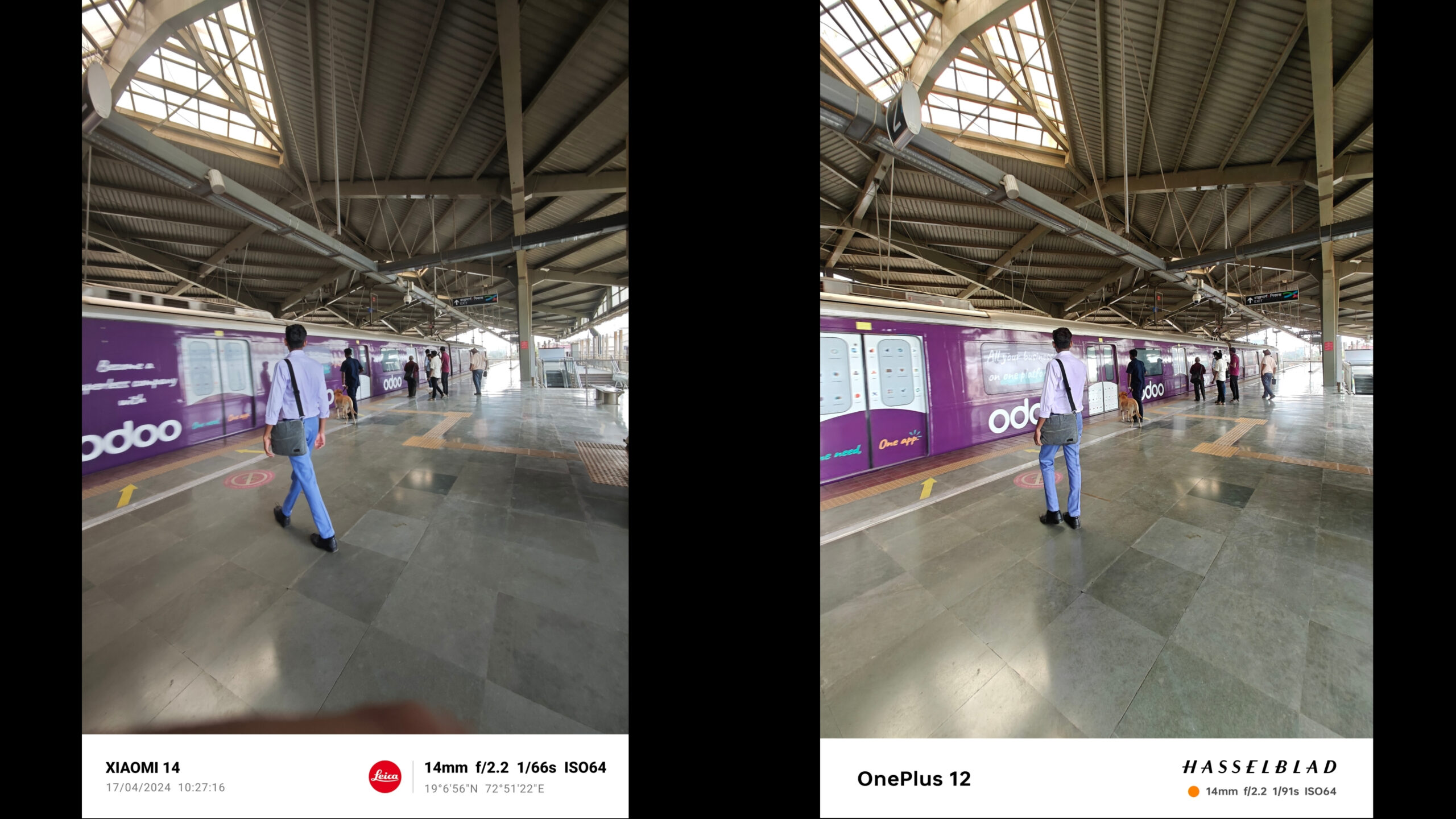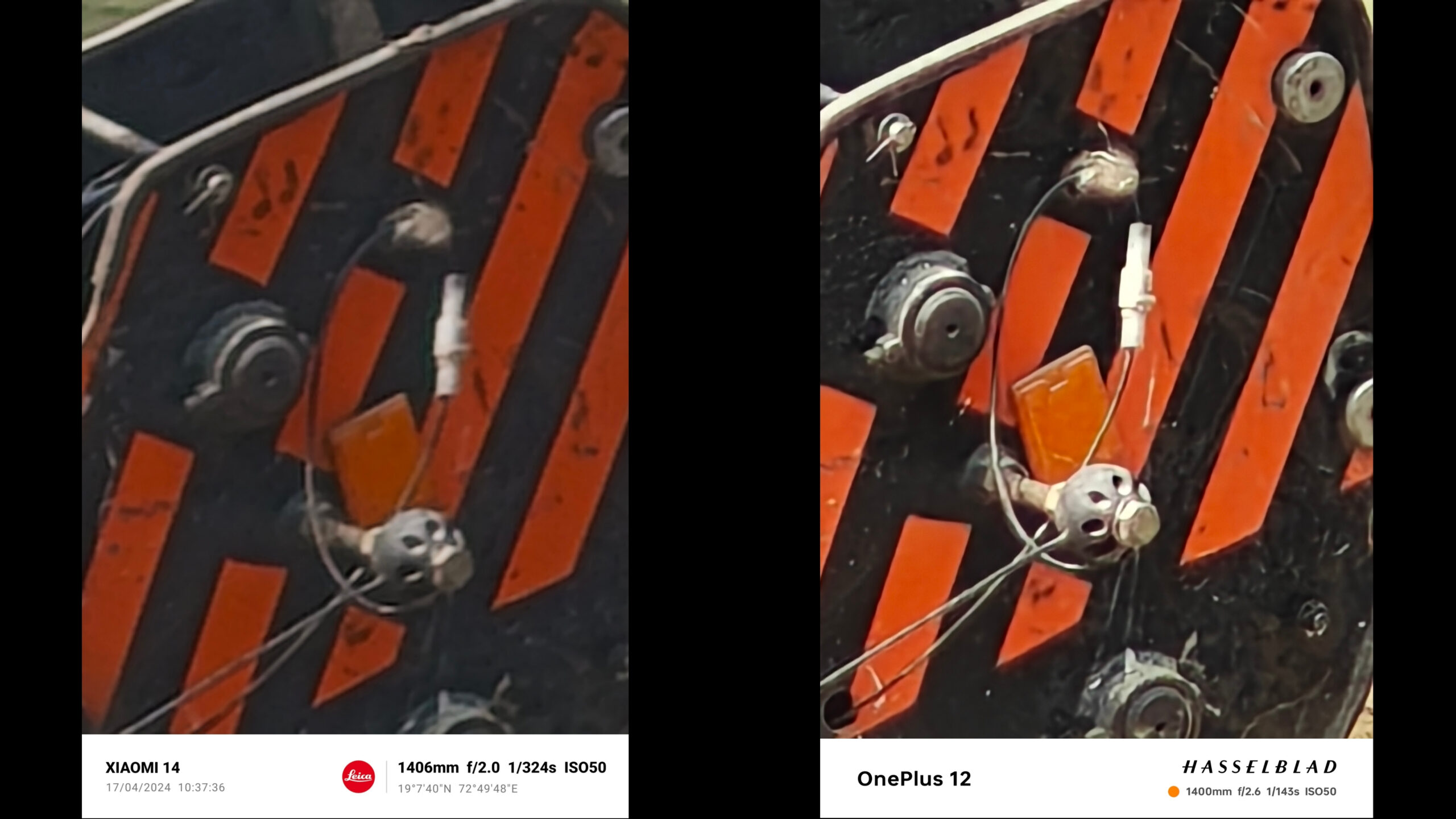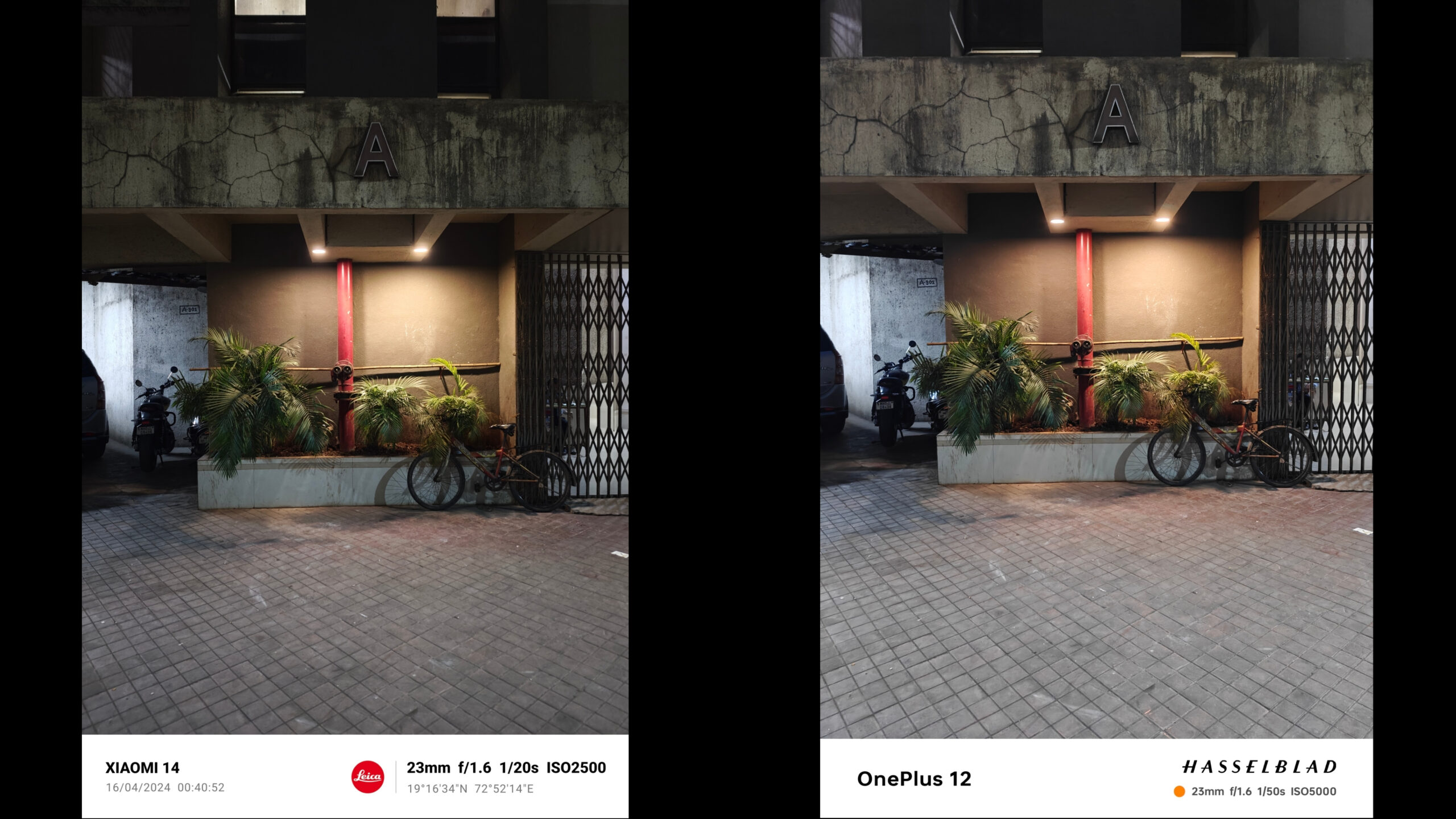The smartphone industry, particularly in the mid-range segment, has become a hotbed for innovation, with camera technology playing a pivotal role. As manufacturers strive to offer premium features at competitive prices, the camera has emerged as a key differentiator for consumers ranging from avid photographers to social media users. We’re examining two new releases priced at ₹69,999 each: The Xiaomi 14, launched in March, and the OnePlus 12, released in January. Positioned below flagship models from Xiaomi and OnePlus, these phones not only compete with each other, but also showcase their prestigious partnerships with iconic camera brands – Xiaomi with Leica and OnePlus with Hasselblad.
In this test, we’ll compare the camera performance of the Xiaomi 14 and OnePlus 12, exploring how these collaborations influence their photographic capabilities. Read the full article to find out which smartphone better suits your photography needs.
Xiaomi 14 Camera Setup
Rear Camera
- 50 MP, f/1.6, 23mm (wide), 1/1.31″, 1.2µm, dual pixel PDAF, Laser AF, OIS
- 50 MP, f/2.0, 75mm (telephoto), PDAF (10cm – ∞), OIS, 3.2x optical zoom
- 50 MP, f/2.2, 14mm, 115˚ (ultra-wide)
- Leica lens, Dual-LED dual-tone flash, HDR, panorama
- 8K@24fps (HDR), 4K@24/30/60fps (HDR10+, 10-bit Dolby Vision HDR, 10-bit LOG), 1080p@30/60/120/240/960fps, 720p@1920fps, gyro-EIS
Front Camera
- 32 MP, f/2.0, 22mm (wide), 0.7µm
- HDR, panorama
- 4K@30/60fps, 1080p@30/60fps, gyro-EIS
OnePlus 12 Camera Setup
Rear Camera
- 50 MP, f/1.6, 23mm (wide), 1/1.43″, 1.12µm, multi-directional PDAF, OIS
- 64 MP, f/2.6, 70mm (periscope telephoto), 1/2.0″, 0.7µm, PDAF, OIS, 3x optical zoom
- 48 MP, f/2.2, 14mm, 114˚ (ultra-wide), 1/2.0″, 0.8µm, PDAF
- Hasselblad Colour Calibration, Dual-LED flash, HDR, panorama
- 8K@24fps, 4K@30/60fps, 1080p@30/60/240/480fps, Auto HDR, gyro-EIS, Dolby Vision
Front Camera
- 32 MP, f/2.4, 21mm (wide), 1/2.74″, 0.8µm
- Auto-HDR, panorama
- 4K@30fps, 1080p@30fps, gyro-EIS
Daylight Main Camera
In the main camera, both phones are equipped with a 50-MP sensor, but the actual output is what truly matters. In this regard, the OnePlus produces images at 14.3 MP while the Xiaomi 14 delivers slightly lower at 14 MP. However, the Xiaomi 14 might have a slight edge in processing due to its use of the latest Omni Vision sensor, compared to the more established LYTIA sensor in the OnePlus.

When it comes to the quality of pictures, both phones seem to provide good results. The images appear sharp and detailed to the naked eye, making it hard to prefer one over the other. Upon closer inspection, however, the OnePlus photos tend to be slightly more saturated, giving them a reddish tinge. Conversely, the Xiaomi produces images that are more natural and true to the original scene. Additionally, the Xiaomi shows superior performance in handling glare, successfully reducing it in most instances where the OnePlus might display some glare. The handling of highlights and shadows by the Xiaomi is also commendable; thanks to a balanced tonal range, it manages to reveal more details in the images.
Daylight Wide Camera
Regarding the ultra-wide cameras, the OnePlus employs a 48 MP Sony IMX581 sensor, while the Xiaomi 14 uses a Samsung ISOCELL sensor. The actual output from the Xiaomi is approximately 14 MP, and the OnePlus produces an output of 13.2 MP. In this aspect, Xiaomi has a clear advantage.

The difference is also visible in the quality of the images. Xiaomi’s images show more natural whites compared to those from OnePlus. However, despite having a lower megapixel count, OnePlus excels by delivering sharper images upon zooming. This suggests that OnePlus has very effective backend processing, though its images are slightly more contrast, which could be a disadvantage.
In indoor settings, Xiaomi occasionally produces images with slightly more contrast than OnePlus, which was unexpected. Moreover, OnePlus images sometimes appear to have a reddish tinge.
Daylight Telephoto Camera
When it comes to telephoto capabilities, the two phones use different sensors. The Xiaomi is equipped with a Samsung ISOCHELL 50 MP sensor that produces a 14 MP output, whereas the OnePlus has a 64 MP OmniVision sensor with an output of 17.6 MP. Their zoom capabilities also vary. The OnePlus offers a zoom range of 3x and 6x, extending up to 120x, while the Xiaomi provides zoom levels of 3.2x, 5x, and 10x, with a maximum of 60x.



The OnePlus has a higher sensor resolution, which results in sharper images across its entire range. As the zoom level increases, the difference in sharpness between the two phones becomes more apparent. For those who prefer sharper images, the OnePlus would be the better choice. However, when it comes to overall image quality, especially at high zoom levels, there is little to distinguish between the two phones as both generally produce good results. Nonetheless, the OnePlus shows some inconsistency in tonal range as the zoom increases, an issue that is not present in the Xiaomi. The Xiaomi may not capture the sharpest images, but it maintains more consistent quality.
Lowlight Main Camera
Recently, there has been an increase in people taking pictures in low light settings, such as during dinners and social outings. In these situations, the Xiaomi’s performance is comparable to the iPhone, as it tends to produce more neutral and natural images. On the other hand, the OnePlus tends to saturate the pictures, which might be preferred by some users because it makes the colours more vivid, and many people like such vibrant pictures.

When it comes to details and sharpness, both the Xiaomi and the OnePlus perform similarly, though the OnePlus might have a slight advantage.
Lowlight Wide Camera
In terms of performance in low-light conditions, both cameras are decent. However, the OnePlus tends to oversaturate the pictures more than the Xiaomi, affecting the visibility of shadows and highlights. Despite this, the OnePlus still produces sharper images in this category.

It’s important to note that the overall performance of both phones varied. Sometimes, the Xiaomi’s images were overexposed, while at other times, the OnePlus’ images were underexposed. Therefore, neither phone delivered flawless results in this segment.
Lowlight Telephoto Camera
Much like its performance in daylight telephoto shots, the OnePlus produces a much sharper image. As one zooms in further, this becomes more evident. At the maximum zoom range of each phone, the images tend to be blurry, yet they appear significantly clearer on the OnePlus.



Although it was anticipated that the OnePlus might display varying colour tones in this aspect, the actual performance was surprisingly better than expected.
Portraits
Xiaomi has consistently performed well in portrait photography over the years, and this was also true for the Xiaomi 13 Pro, which received positive reviews. The brand’s portrait mode, although good, takes a unique approach by incorporating Leica filters, which might be confusing to new users who could initially think there are only two shooting options available.


Both Xiaomi and OP deliver high-quality images that are sharp, well-saturated, with good edge detection and bokeh effect. However, Xiaomi’s portraits are particularly appealing, especially in how they handle skin tones, making them appear more natural, saturated, and warm, thus pleasing to the eye. In contrast, OP offers better blur and sharpness, especially at higher focal ranges, but sometimes struggles with inconsistent tonal ranges.
Front Camera
Both phones feature a 32-megapixel front camera; however, the OnePlus offers only a single setting for taking pictures, while the Xiaomi 14 provides options for both wide-angle and standard (1X) shots. An interesting feature of the Xiaomi 14 is that it uses a timer when the volume down button is pressed to take a picture.


In terms of image quality, the OnePlus produces more natural-looking photos, whereas the Xiaomi enhances the exposure to make the images appear more striking. The Xiaomi 14 also has skin smoothing turned on by default, which users may want to disable for a more natural appearance. When capturing portraits, both phones deliver good detail and edge detection, but the Xiaomi slightly outperforms in terms of the sharpness of the details.
Video Performance
Both phones can record video up to 8K at 24 fps, though this feature has not been tested as it is unlikely to be used frequently by most consumers in the near future. When recording in 4K, both devices can shoot up to 60 fps. In this mode, the OnePlus generally produces better videos. Video stabilization is effective on both devices, but the Xiaomi tends to display more contrast, which can make some videos look underexposed. This was observed with HDR turned off as well, and some glare was noticeable in the videos shot with the Xiaomi 14.
In low-light conditions, however, the increased contrast in Xiaomi’s videos results in better visual quality. Additionally, the Xiaomi outperforms the OnePlus in terms of flare handling in these settings. It is also worth mentioning that Xiaomi’s sound recording quality is superior.
Overall, the OnePlus is favoured for its better overall performance.
Conclusion
Which phone has the better camera, the Xiaomi or the OnePlus? In this comparison, the Xiaomi 14 seems to have the advantage. It captures neutral photos under most conditions, which is highly appreciated. Additionally, it produces warmer-looking portraits, which seems to be popular among users. Although it doesn’t perform as well as the OnePlus in video recording, its superior macro capabilities contribute to it having a better camera overall.
The choice might differ if considering the overall quality of the phone, where factors like the operating system, usability, and display come into play. However, it’s worth noting that the Xiaomi 14’s user interface has improved significantly with the introduction of Hyper Touch OS. Expectations are that it will continue to get better with future updates.
